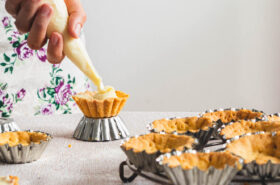Regarding gastronomy, I always talk about how much my childhood memories of the summers spent in my grandparents’ house in the countryside influenced me. As a typical city girl, I woke up around 9; whenever I asked about my grandfather, the answer was, “He is outside gardening”. His care and love for his own fruits and vegetables are the roots of respect I feel now for fresh ingredients. However, my grandparents’ garden was very traditional in the sense of being 100% focused on local products. They had never really done any experiments with new species or tried to plant seeds that weren’t autochthonous. And this was the case with growing herbs: only the distinctive and subtle aroma of parsley and dill filled the air.

But that was perfectly understandable. My grandparents were born right before WWII and had first-hand experience with the post-war food shortage. They planted exclusively what they were 100% sure would give fruit, which didn’t leave room for tests. They tried to make ends meet by implementing zero-waste gastronomy out of necessity rather than following a culinary trend as we see it nowadays. Compared to them, my mom’s culinary vision widened significantly: in the 80s, along with my father, she hitchhiked around the soviet countries trying vodka with herring in Moscow, borscht soup in Latvia or cabbage pierogi in Gdansk, Poland.
At that time, they travelled with only a hundred marks in their pockets, so the meagre lifestyle of a university student didn’t allow them any high-end gastronomic whim. Later, in the 90s, they made several trips around France with a keen eye on food and wine. This was the first time my mom had ratatouille with fresh thyme and tasted rosemary-flavoured goat cheese. She discovered the potential fresh herbs had in store, and an entire culinary world opened up for her. However, returning from France, the question of how to grow herbs outdoors, I mean planting herbs on the balcony of a tenth-floor panel apartment, arose. Back then, in Hungary, a country that had recently been liberated from the socialist regime and entered western capitalism, going to the closest supermarket and buying a pot of cilantro was unimaginable. Truth be told, people didn’t know what fresh cilantro meant at all. So, emulating the typical school project, we started to germinate seeds in wet paper towels with less than more success.
The years passed and following in my parents’ footsteps, I discovered the joy of travelling. During my university years spent in Southern Spain and Argentina, I tasted herbs and spices I hadn’t even heard about before, tried products and dishes completely unknown, and learned the love-or-hate relationship that people had with cilantro. Once having returned to Europe, these were flavours I was not willing to renounce. For the last seven years, I have been running my own household. My husband and I have lived in different European cities. Still, no matter how small our kitchen window or the balcony was, there has always been enough space for 5 or 6 herb pots.

Besides the common herbs like mint, basil, thyme or chives, I experiment with some new culinary herbs each year. In my current herbs garden grows the fragrant sage, whose soft leaves remind me of the velvet cushions on my grandmother’s couch. Or the anise-like Thai basil that makes me wonder about the trip to Asia I wrote to my bucket list ages ago. Or the Peruvian mint that recalls sweet memories of my excursion to the Andes.
How to freeze and dry herbs
Now that summer is over and I ask myself how will my herb garden survive winter in The Netherlands, I try to maximize and prolong their use. Being the freezer queen, I assure you that freezing fresh herbs is absolutely possible. Here are some handy tips for enjoying the delicious tastes of homegrown herbs in the forthcoming months. Harvest the herbs you would like to freeze; after washing them, dry the herbs in a kitchen towel. I cut off the stems of the herbs and use only the leaves, except for the cilantro, which has most of its flavours in the stem. Portion them into handfuls, shape them into small cylinders, then wrap them in aluminum foil. Put the same type of herbs in a bag and label them, so you will know which is which for sure. Take them out five minutes before you want to use and stir them into your food.

If you want to prepare homemade dried herbs, follow the first steps above. Once the harvested herbs are dry, gather 4-5 stems and tie them together in a bouquet. Hang them upside-down in a darker place/where they are not exposed to direct sun and leave them dry for about a week. When they are completely dry, take the bouquets down, place them over a piece of baking paper, pull the leaves off the stems, and put them in a canned jar or small container. Store the dried herbs in a drawer or a cool, dark cupboard, and enjoy the taste of summer whenever you carve for it.
My philosophy is to cook traditional dishes with a modern and creative twist. I scent my childhood-inspired English pea cream soup with mint, I dare to sprinkle chives and thyme over the stuffed cabbage, and I serve my parents grilled corn cream soup with cilantro leaves whenever they are on a visit. Not sure my father loves them or hates them, but at the end of the day, who said kids couldn’t teach their progenitors?
